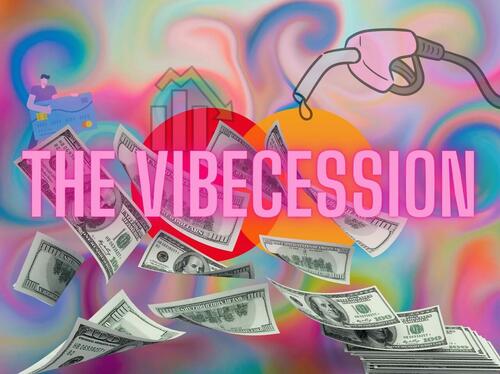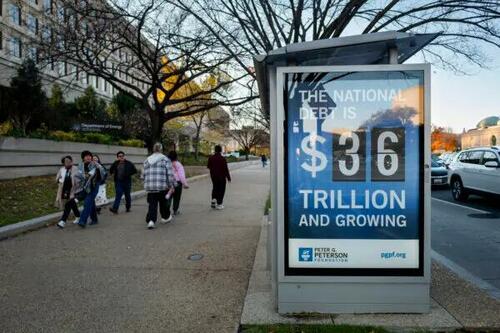
A Tale Of Two Economies: The 'Vibecession’ Of The Past 4 Years
Authored by Andrew Moran via The Epoch Times,
Economists have described the past four years as the “vibecession,” a disconnect between Americans’ feelings about the economy and the data.

It was the consensus view on Wall Street that the economy would slide into a recession, but economic conditions have defied expectations. Gross domestic product (GDP) has expanded at a solid pace, the labor market has added millions of new jobs, and the inflation growth rate has eased from its June 2022 peak.
If this is the current state of the world’s largest economy, why have U.S. households been down?
Federal Reserve Chair Jerome Powell was asked about this at the December post-policy meeting press conference, and he attributed this pessimistic view to the “tremendous pain” of high prices.
“Prices went up by a great deal, and people really feel that, and it’s prices of food and transportation and heating your home and things like that. So there’s tremendous pain in that burst of inflation that was very global,” Powell said.
“Now we have inflation itself is way down, but people are still feeling high prices. And that is really what people are feeling.”
Indeed, inflation has been and continues to be the main story in today’s economy.
Inflation and GDP
Over the past four years, inflation has eaten away many gains made throughout the economy.
Consumer prices have soared by about 21 percent, while producer prices—a gauge of prices paid by businesses for goods and services at the wholesale level—have surged by about 24 percent. Americans’ purchasing power has also eroded by 17 percent.
The current administration has touted the labor market’s strength, with wage growth at the top of its accomplishments. While nominal (non-inflation-adjusted) wage growth has soared, real (inflation-adjusted) wage growth has been stuck in subzero terrain throughout President Joe Biden’s term.
As a result, households have been struggling to keep up with sky-high living expenses, whether utilities or food.
At the same time, the inflation bomb that went off in the aftermath of the COVID-19 pandemic also weighed on economic advances.
Retail sales, for example, have soared, indicating that consumers have strong balance sheets. However, after adjusting for inflation, retail sales have flatlined, suggesting that consumers spent more for the same or less.
Some economists assert that inflation might have been undercounted and growth overstated.
In October, economists EJ Antoni and Peter St Onge published a study in Brownstone Journal, concluding that the cumulative inflation has been understated by nearly half and cumulative growth might have been “overstated by roughly 15 [percent].”
“Even without considering population growth and per capita GDP, the adjusted real GDP values imply that the nation entered a recession in the first quarter of 2022 and remained in that contraction through the second quarter of 2024,” they wrote.
That said, the official U.S. government data suggest that growth prospects have been robust, even in a climate of higher interest rates and geopolitical risks.
Under the Biden administration, real GDP rose by 12.6 percent, according to the White House. In 2024, the United States is poised to register a 2.5 percent growth rate.
By comparison, his predecessor, President Donald Trump, oversaw an economy that expanded by about 7 percent.
Spending and Deficits
The federal government is running a sizable budget deficit as if it were in a recession, war, or pandemic.
Despite that the economy is growing and running at full employment, the deficit as a share of the GDP is about 7 percent. The last times the deficit-to-GDP ratio was this high were during the global financial crisis and the COVID-19 pandemic.

The national debt clock at a bus station in Washington on Nov. 26, 2024. Madalina Vasiliu/The Epoch Times
Washington faces a challenge because spending continues to grow. Federal outlays are up by 47 percent from before the public health crisis, exceeding $7 trillion.
Likewise, the national debt has increased by more than $8 trillion since January 2021, reaching $36.2 trillion.
Although resilient consumers and their spending patterns have been the main drivers of meteoric growth, government consumption has also played a prominent role in the economy’s growth.
In the third quarter, when the U.S. economy rose by 3.1 percent, expenditures from all three levels of government contributed 28 percent to the rise in GDP.
At the federal level, net government outlays account for less than one-quarter of the GDP, up from about one-fifth before the pandemic.
The economic literature states that cutting government spending would be a net benefit for the economy. More resources would stay in the private sector and be efficiently allocated toward productive uses rather than government edicts.
A significant portion of federal revenues has been dedicated to debt servicing payments, which are taxpayer funds that will not produce anything critical for the long-term success of the broader economy.
Consumer Sentiment
From higher prices to ballooning debt, households maintained a sour outlook on the economy.
NBC News exit poll data show that heading into the voting booth on Election Day in November, nearly half (45 percent) of voters said they were financially worse off than they were four years earlier.
Consumer sentiment improved in December for the fifth consecutive month. Despite the jump, the public’s view of the economy has failed to return to pre-crisis levels.
The widely watched University of Michigan Consumer Sentiment Index reached an all-time high in February 2020. After plummeting to a record low in June 2022, it has steadily rebounded, although it is still below the high observed under the previous administration.
Alternatively, the Conference Board’s Consumer Confidence Index has also failed to recover from its highs in 2018 and 2019.
Over the past four years, households have endured daily sticker shocks, whether for a carton of eggs or a visit to the dentist. Many goods and services are more expensive, and consumers see their paychecks unable to cover these higher costs.
This has forced millions of Americans to take on more debt.
According to New York Fed statistics, household debt has soared by about $3.3 trillion since the first quarter of 2021. One culprit of this upward trend has been credit card debt, which rose by approximately $400 billion in this span to a record $1.17 trillion.
An October Civic Science survey found that 41 percent of Americans rely on debt to stay afloat.
The 2025 Outlook
According to a recent Bankrate survey, 44 percent of Americans think their personal financial situation will improve next year, up from 37 percent at the end of 2023.
The top financial objective for 21 percent of Americans? Paying down debt.
“Inflation has faded, but it hasn’t gone away,” Mark Hamrick, senior economic analyst at Bankrate, said in a statement.
“With interest rates still elevated, it is encouraging to see the top financial goal is to pay down debt. Average credit card interest rates top 20 [percent], still close to a record high. Targeting high-cost debt can provide an immediate benefit.”
Eradicating price inflation from the collective consciousness of the American people might be the road to bolstering consumer sentiment in 2025 and beyond.
Tyler Durden
Fri, 12/27/2024 – 14:05















